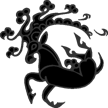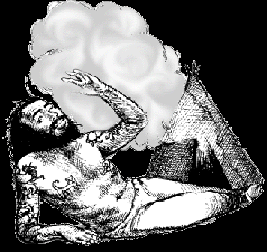 It is most likely the seeds described by Herodotus were seeded buds, and that the charred seeds found by archeologists are what was left over from the burnt buds.
It is most likely the seeds described by Herodotus were seeded buds, and that the charred seeds found by archeologists are what was left over from the burnt buds.
 Proving the Myth
Proving the Myth Herodotus’ ancient records of the Scythian hemp rites were once believed to be mythical, but they were verified in 1929, with the discovery of a Scythian tomb in Pazyryk, Western Altai, by Professor S. I. Rudenko. As cannabis expert Ernest Abel explains in Marihuana, the First 12,000 Years:
Herodotus’ ancient records of the Scythian hemp rites were once believed to be mythical, but they were verified in 1929, with the discovery of a Scythian tomb in Pazyryk, Western Altai, by Professor S. I. Rudenko. As cannabis expert Ernest Abel explains in Marihuana, the First 12,000 Years:
 Digging into some ancient ruins near the Altai Mountains on the border between Siberia and Outer Mongolia, Rudenko found a trench about 160 feet square and about 20 feet deep. On the perimeter of the trench were the skeletons of a number of horses. Inside the trench was the embalmed body of a man and a bronze cauldron filled with burnt marihuana seeds!
Digging into some ancient ruins near the Altai Mountains on the border between Siberia and Outer Mongolia, Rudenko found a trench about 160 feet square and about 20 feet deep. On the perimeter of the trench were the skeletons of a number of horses. Inside the trench was the embalmed body of a man and a bronze cauldron filled with burnt marihuana seeds!
 Clearing the site further, Rudenko also found some shirts woven from hemp fibre and some metal censors designed for inhaling smoke which did not appear to be connected with any religious rite. To Rudenko, the evidence suggested that inhalation of smoldering marihuana seeds occurred not only in religious context, but also as an everyday activity in which Scythian women participated alongside the men.
Clearing the site further, Rudenko also found some shirts woven from hemp fibre and some metal censors designed for inhaling smoke which did not appear to be connected with any religious rite. To Rudenko, the evidence suggested that inhalation of smoldering marihuana seeds occurred not only in religious context, but also as an everyday activity in which Scythian women participated alongside the men.
 The Encyclopedia Brittanica describes the cauldrons found at these Scythian burial sites as follows:
The Encyclopedia Brittanica describes the cauldrons found at these Scythian burial sites as follows:
 These cauldrons varied in size from quite small examples to others weighing as much as 75 pounds. An overwhelming majority have a solid base, shaped like a truncated cone, around which the fire was heaped. The upper section is a hemispherical bowl… with handles (shaped like animals) fixed to the rim opposite each other… at Pazyryk, small cauldrons filled with stones and hemp seeds were found standing beneath leather or felt tentlets with three or six supports.
These cauldrons varied in size from quite small examples to others weighing as much as 75 pounds. An overwhelming majority have a solid base, shaped like a truncated cone, around which the fire was heaped. The upper section is a hemispherical bowl… with handles (shaped like animals) fixed to the rim opposite each other… at Pazyryk, small cauldrons filled with stones and hemp seeds were found standing beneath leather or felt tentlets with three or six supports.
 It is known that sacrifices took place with the death of a Scythian king, as the physical evidence collected by archeologists can attest to. For 40 days after the death of a king, the mourners would travel the country conducting the king’s dead body through the lands he had ruled in life. After this the body was taken to a tomb for burial, where a massive sacrifice took place, not only of horses, but of humans as well. The king’s wives, cupbearers and principal servants were destined to join him, willingly or not, in the afterworld.
It is known that sacrifices took place with the death of a Scythian king, as the physical evidence collected by archeologists can attest to. For 40 days after the death of a king, the mourners would travel the country conducting the king’s dead body through the lands he had ruled in life. After this the body was taken to a tomb for burial, where a massive sacrifice took place, not only of horses, but of humans as well. The king’s wives, cupbearers and principal servants were destined to join him, willingly or not, in the afterworld.
The Great Goddess Two extraordinary rugs were also found in the frozen Scythian tombs. One rug had a border frieze with a repeated composition of a horseman approaching the great goddess Tabiti-Hestia, the patroness of fire and beasts. She is depicted as holding the “Tree of Life” in one hand and raising the other in welcome.
Two extraordinary rugs were also found in the frozen Scythian tombs. One rug had a border frieze with a repeated composition of a horseman approaching the great goddess Tabiti-Hestia, the patroness of fire and beasts. She is depicted as holding the “Tree of Life” in one hand and raising the other in welcome.
 Tabiti-Hestia is the only deity who figures in Scythian art. Considering the barbaric nature of these people it is interesting that she is a female, but perhaps really not all that surprising, as many of the peaceful goddesses became more fierce in the transition from matriarchy to patriarchy.
Tabiti-Hestia is the only deity who figures in Scythian art. Considering the barbaric nature of these people it is interesting that she is a female, but perhaps really not all that surprising, as many of the peaceful goddesses became more fierce in the transition from matriarchy to patriarchy.
 In The Woman’s Book of Myths and Secrets, Barbara Walker writes about the Scythian religion.
In The Woman’s Book of Myths and Secrets, Barbara Walker writes about the Scythian religion.
 The only deity shown in Scythian art was the Great Goddess, whom the Greeks called Artemis, or Hestia or Gaea (The Earth)… Scythians were governed by Priestess-Queens, usually buried alone in richly furnished Kurgans (queen graves)…
The only deity shown in Scythian art was the Great Goddess, whom the Greeks called Artemis, or Hestia or Gaea (The Earth)… Scythians were governed by Priestess-Queens, usually buried alone in richly furnished Kurgans (queen graves)…
 The moon-sickle used in mythical castrations of God was a Scythian weapon. A long-handled form therefore came to be called a scythe, and was assigned to the Grim Reaper, who was originally Rhea Kronia [the old crone] in the guise of Mother Time, or Death- the Earth who devoured her own children. Scythian women apparently used such weapons in battle as well as religious ceremonies and agriculture.
The moon-sickle used in mythical castrations of God was a Scythian weapon. A long-handled form therefore came to be called a scythe, and was assigned to the Grim Reaper, who was originally Rhea Kronia [the old crone] in the guise of Mother Time, or Death- the Earth who devoured her own children. Scythian women apparently used such weapons in battle as well as religious ceremonies and agriculture.
 The Scythian Queens
The Scythian Queens One thing that differentiates the tombs of royal Scythian queens from that of the kings is the complete lack of brutal sacrifices.
One thing that differentiates the tombs of royal Scythian queens from that of the kings is the complete lack of brutal sacrifices.
 In the 1994 November issue of High Times, staff reporter Bill Weinberg reported on a more recent Scythian discovery:
In the 1994 November issue of High Times, staff reporter Bill Weinberg reported on a more recent Scythian discovery:
 The newest find is from the remote Altai mountains of Siberia- specifically, from the archeological dig at Ukok, near where the borders of Russia, China, Mongolia, and Kazakhstan meet. Russian scientists found the 2,000-year-old mummified remains of a Scythian queen elegantly laid out in white silk alongside horse harnesses, a mirror, dishes- and a small ceremonial container of cannabis. The July 13 New York Times report on the find says archeologists believe Scythian pot “was smoked for pleasure and used in pagan rituals…”
The newest find is from the remote Altai mountains of Siberia- specifically, from the archeological dig at Ukok, near where the borders of Russia, China, Mongolia, and Kazakhstan meet. Russian scientists found the 2,000-year-old mummified remains of a Scythian queen elegantly laid out in white silk alongside horse harnesses, a mirror, dishes- and a small ceremonial container of cannabis. The July 13 New York Times report on the find says archeologists believe Scythian pot “was smoked for pleasure and used in pagan rituals…”
The Enigmatic Enaries Cannabis was not only used by the Scythians for relaxation and ceremonies for the dead. These ancient nomads had a class of shaman-magicians called the Enaries. These were ancient transvestites who uttered prophecies in high pitched voices. This at first sounds bizarre, but was actually a very common trait among shamans world wide. The Scythians believed that these people, who had characteristics of both sexes, were somehow also living in both worlds, and could travel between the two.
Cannabis was not only used by the Scythians for relaxation and ceremonies for the dead. These ancient nomads had a class of shaman-magicians called the Enaries. These were ancient transvestites who uttered prophecies in high pitched voices. This at first sounds bizarre, but was actually a very common trait among shamans world wide. The Scythians believed that these people, who had characteristics of both sexes, were somehow also living in both worlds, and could travel between the two.
The Thracians Of the groups directly influenced by the Scythian use of cannabis, probably the most notable would be the red-haired, fair-skinned Thracians.
Of the groups directly influenced by the Scythian use of cannabis, probably the most notable would be the red-haired, fair-skinned Thracians.